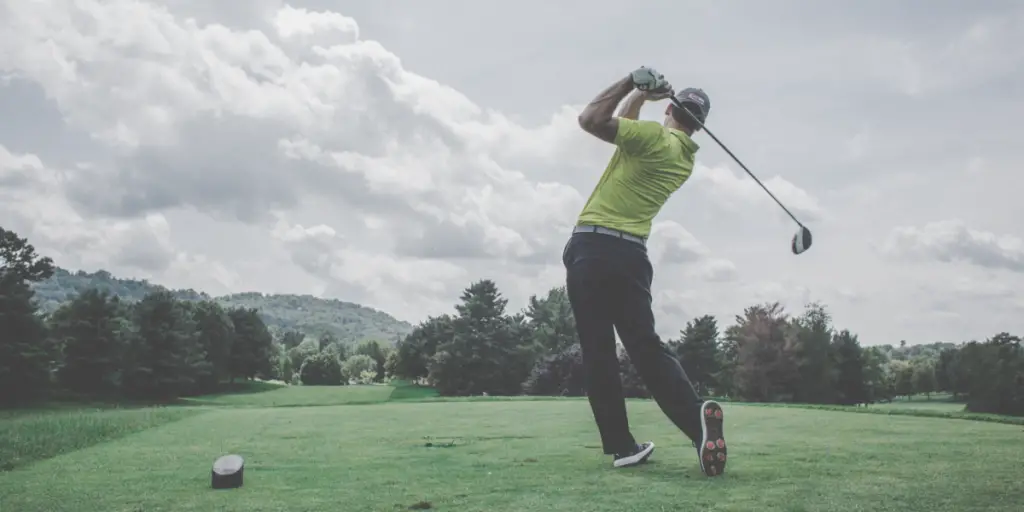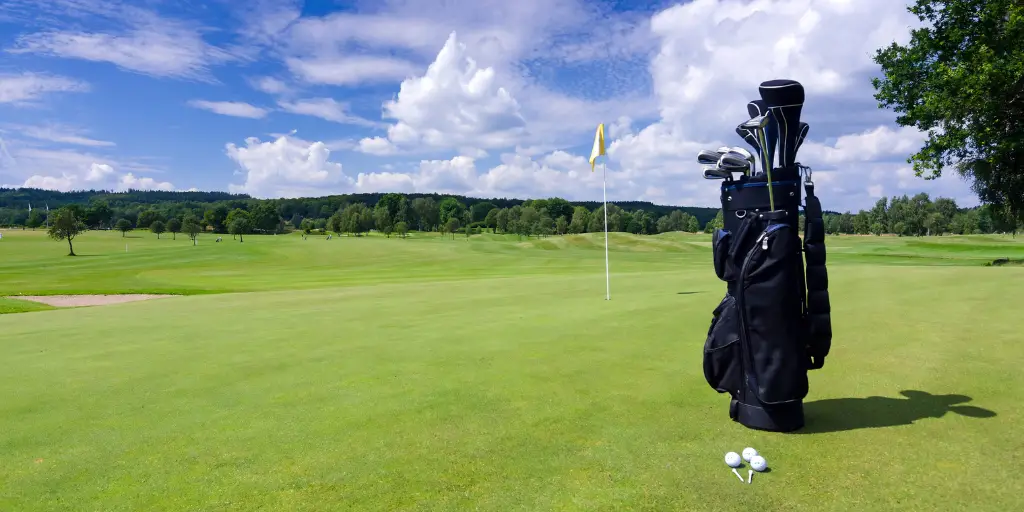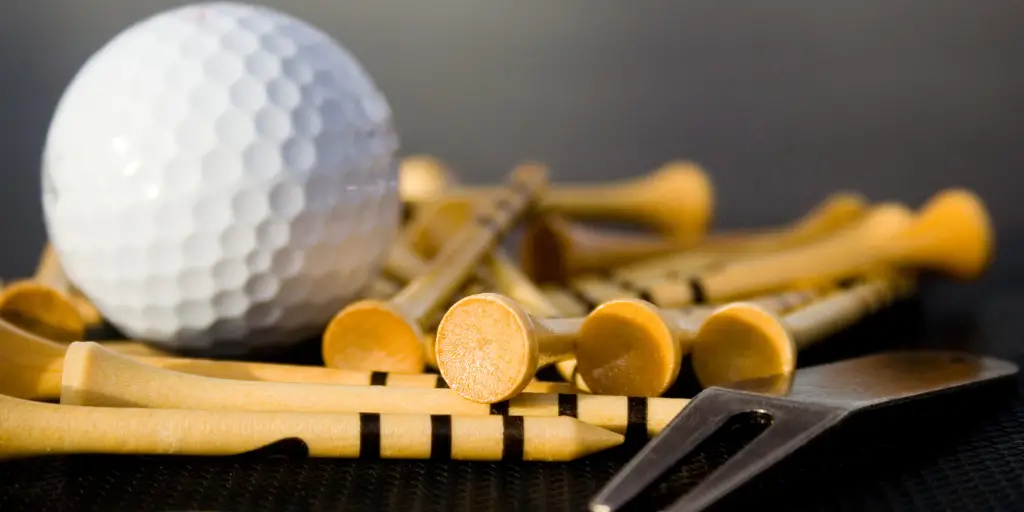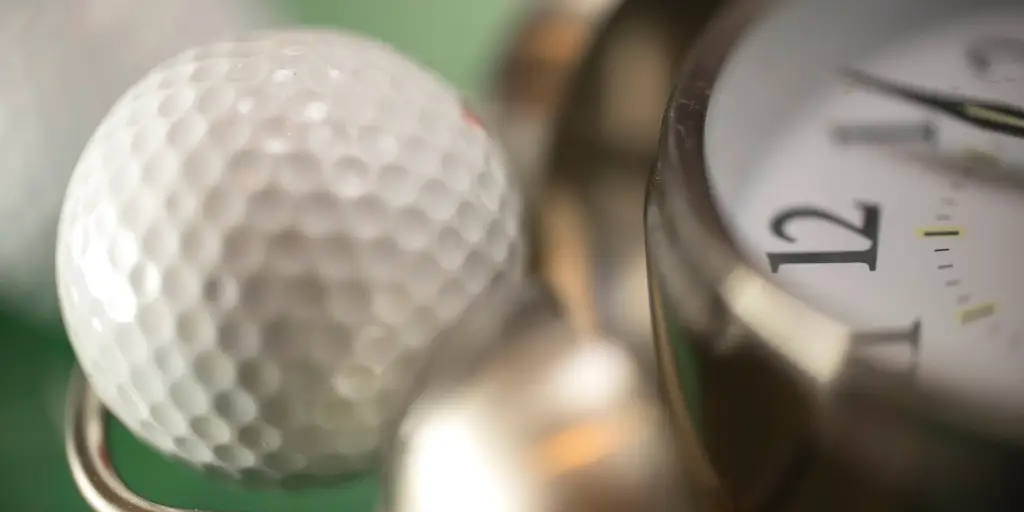“Golf can best be defined as an endless series of tragedies obscured by the occasional miracle.” – Anonymous
The game of golf can be frustrating and maddening but in that single moment when a pure golf shot is made, completely satisfying. You can’t help it, you’re hooked and you just want more!
At first glance, the game can seem overwhelming with so much information out there; equipment, rules, etiquette, lingo, etc. However, getting up to speed on the basics of how to play golf is much easier. The following guide will help you get an understanding of the equipment, golf swing, how to practice, and then put it all together for the course. Our goal is to help you shoot lower scores, reduce your handicap, and enjoy the game even more!
Equipment Basics
Bare Necessities
Clubs
The first thing that every golfer will need is a set of clubs and there are only 4 broad types of golf clubs:
Woods

Hybrids
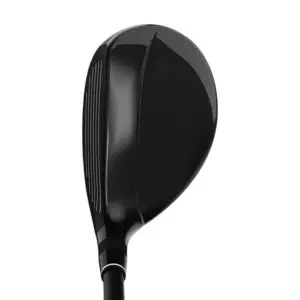
Irons
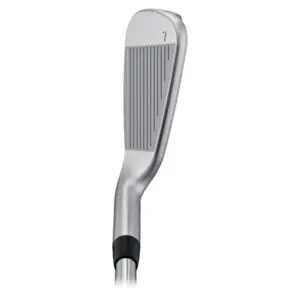
Putters

There can be various different subcategories of these 4, but golf clubs will all fall into 1 of the 4.
A beginner golf set should have at least the following:
By having this basic set composition, you shouldn’t find yourself in positions without the proper club for the right distance.
Balls
The second most important thing you will need are of course golf balls. Now we could dive into the details of all the different types of balls and provide a comprehensive guide but that’s a topic for a different article.
In order to keep things simple, we like a distance golf ball that costs no more than $15-20 for a 12-18 pack or around $1/ball.
There are premium golf balls that cost around $4/ball but as a beginner, you’ll probably be losing 3-6 balls per round so spending around $1/ball is a smarter financial decision.
Finally, distance balls spin less and won’t stray as far off online on poorly struck shots.
Tees
When you step onto the tee box or go to a grass driving range, you’re going to want to put the golf ball onto a little thing called a tee.
Placing a ball on a tee, as opposed to just placing it directly on the ground, allows the ball to be elevated and makes it easier for making solid contact.
The most common tee is made out of wood but there are also more expensive types made out of plastic or have some sort of brush. We like the basic wood tee that’s 3 ¼ inch length that can accommodate today’s larger drivers.
Golf Bag
Finally in order to carry around all of the above equipment, a golf bag is a must. Just like everything else, there are multiple different types of bags; cart bags, tour bags, stand bags, etc.
For beginners, we like a simple lightweight bag that has plenty of zipper pockets to carry your balls and tees. In addition, whether you decide to walk or ride a cart, a lightweight bag is much easier to carry around the course.
Highly Recommended
Golf Glove
Could you play without a glove? Yes. But seeing that you’re only connection to the golf club is with your hands, having a glove allows you to maintain a better grip, especially if you’re hands get sweaty or if the golf grip gets wet.

One thing you might come across is something called a “cadet” size glove. These gloves have shorter finger lengths and wider palm widths and are specifically made to provide a better fit for us stubby fingered golfers!
You can get a good quality glove that only costs $10-15. Check out this article about the best gloves on the market!
Shoes
Golf shoes are nice to have but aren’t required. I’ve personally played a few rounds with some basic sneakers.
If you’re playing in wet conditions or early in the morning with dew still on the course, golf shoes with some sort of special grip are highly recommended so your feet won’t be sliding around during your swing.
Ball Marker
The good thing here is that you don’t need anything special here other than a basic coin!
When your ball is on the green, you’re allowed to pick it up and clean it. In order to remember where your ball was, you need to replace your golf ball with a ball marker. Could you get away with using a golf tee stuck in the ground? Yes, but a coin is what the pros use!
Swing Basics
There certainly isn’t a shortage of information on how to golf so what we want to focus on here are the basics that most people can agree on.
G.A.S.P
This is an acronym I came across to remember the 4 golf swing fundamentals; grip, aim, stance, and posture.
Grip
The way you position your hands on the golf club plays a significant role in how the club face makes contact with the ball and the direction in which the ball starts off.
There are 3 types of grips a golfer can have; strong, neutral, or weak.
As a beginner golfer, a “strong grip” is generally better since this will help counteract the tendency to hit a slice (a weak type of golf shot that strays to the right of the target for a right handed golfer).
Aim
One of the biggest mistakes beginner golfers make, is not lining up to your target properly. Ideally, you should be lined up parallel or even slightly left (for right handed golfers) of your target line.
As opposed to other sports where you face directly down your target line (imagine throwing a baseball), the golf swing makes you stand parallel to your target line.
For a right handed golfer, this orientation usually causes you to aim right of the target.
A very simple drill to make sure you’re lining up to the target line correctly is after you take your stance, line up a club across your toe line.
From there, step back behind your ball and look down your target line to make sure your toe line is parallel to your target line.
Stance
The golf swing is an athletic move, just like swinging a baseball bat or a hockey stick, so having a balanced athletic stance is equally important.
Your weight should be equally distributed on your left and right feet and you shouldn’t have too much weight on either your toes or your heels.
Your feet should be roughly shoulder width apart for hitting irons and just slightly wider than shoulder width for hitting woods.
Finally, your legs shouldn’t be locked or shouldn’t be bent so much like you’re doing a squat. You should have just enough knee flex to be able to move athletically in either direction.
Posture
Your posture, just like you stance, needs to be athletic and balanced. As you place your club behind the ball and are ready to swing, you want make sure you doing 3 final things:
-
-
- Bending from the hips
- Arms hanging directly below your shoulders (not “reaching out” with your arms or too close to your body)
- Chin slightly up
-
Ball Position
Where you position the ball in your stance is determined by the club that you’re using.
For wedges and short irons, you should position the ball in the middle to back of your stance since you’ll be swinging more down and through the ball
For mid and long irons, you should position the ball between the middle of your stance and inside of your left instep (for right handed golfers)
Finally for fairways woods and drivers, you should position the ball inside of your left instep since you’ll be swinging more up and through the ball.
Takeaway
Once you’ve established the 4 fundamentals for a good setup, the takeaway, or the first couple feet of the start of the backswing are important because it sets up the remainder of the backswing and then the downswing.
If you have a poor takeaway, then you’re going to be at bad position at the top of the swing (the point where you begin the downswing) and will therefore have to make some sort of adjustment in the downswing. The less manipulation you have to do, the more consistent your swing will become.
In the takeaway, you want to focus on taking the club back with your chest and shoulders and not using your hands. After the takeaway, the main focus should just be keeping the left arm as straight as possible (in order to create a wide arc and generate more speed), hinging the wrists, and making a good shoulder turn.
Downswing
The downswing begins when the golf club starts heading back towards the ball. At this point, your primary thought should be shifting your weight to your left side (for a right handed golfer) and swinging through the ball not at the ball.
Make sure your grip pressure isn’t too tight which will allow you to release the club and have your right hand rollover your left hand. Releasing the club head allows for more power and increased shot distance.
When finishing the swing you should end up standing tall with most of your weight on the outside of your left foot and little weight on your right tippy toes.
One final thought for beginners; when you’re doing a full golf swing you should only think about swinging smooth and at about 75% off full effort. Your main focus right now isn’t about hitting the ball as hard as possible but rather making solid contact.
Take Lessons
While there are plenty of golf tips for beginners online, we also recommend taking lessons from an experienced PGA (professional golf association) professional to help instill the correct habits.
Like any athletic movement, building muscle memory allows you to swing with very few thoughts. When you have bad habits and flawed muscle memory, changing your swing is much more difficult.
Building a solid foundation is incredibly important and PGA pro can help with this. When you have an extra set of eyes that understand the complexity of the golf swing it can set you on the path to building a repeatable and consistent golf swing.
Short Game Basics
Pitching
A pitch shot is a golf shot is generally inside of 50 yards that has more air time and less time rolling on the ground. These shots are usually designed to clear some sort of hazard like a sand trap, water hazard, or rough then land softly on the green then roll forward.
A pitch is very similar to a regular golf shot with a wedge but is only using a half or quarter swing as opposed to a full length swing.
Chipping
A chip shot is another short golf shot that normally has less air time and more time rolling on the ground. Whether you’re trying to hit a chip shot low or high, there are 4 things to keep in mind when doing a chip:
-
- Narrow stance
- Toe line open to target line
- Weight forward
- Hands forward
Putting
It’s not fancy but is probably one of the most unappreciated yet important aspects of the game for beginners. There’s a reason for the saying “Drive For Show, Putt For Dough”!
There are so many different ways to putt and different types of putters to use but there are some basics that remain consistent no matter how you putt.
Just like the normal golf swing, you want an athletic base with good knee bend. In addition, you want to swing the putter with your shoulders and chest but not use your hands too much. Finally your head should remain still throughout the stroke.
With these basics in mind, the key to any putting stroke are 2 things:
-
- Get the ball rolling end over end
- The proper line at the proper speed.
If you’re able to do these 2 things consistently, you’re on the way to being a solid putter.
Practice, Practice, Practice
Have A Purpose
In order to improve as a golfer, you have to practice and your practice should have purpose. The last thing you want to do is go to the range and hit 3 buckets of balls aimlessly.
Whether you’re trying to develop a certain feeling or be at a certain position in your golf swing, there should always be a goal in mind.
For example, if you discover that you’re takeaway is getting too “handsy” instead of using your chest and shoulders, you’re goal for your practice session should be to develop the proper takeaway until it becomes second nature.
Have A Structure
Now that you identified what you want to work on, you should then practice that feeling in a progressive way until you can execute how you would actually make that swing on the golf course. Here’s the structure we like when working on something new:
-
- Start with a tee – it’s hard enough to hit a ball off the ground but it’s going to be that much harder trying to hit a ball off the ground with an unfamiliar movement or feeling. Have you ever seen a major league baseball player practice? He doesn’t step in a batting cage trying to hit 100 mile per hour fastballs right away! He usually drills something by hitting it off a batting tee. We should take the same approach in golf!
- Half swings – practice your movement/swing with only half swings. Just like the hitting a ball directly off the ground, trying to do something different with a full swing is going to be difficult. Focus on developing the feeling on 10-15 half swing shots consistently.
- Full swings – now do the same thing as you did with the half swing, with a full swing. Focus on developing the feeling on 10-15 full swing shots consistently.
- Remove tee – at this point you can remove the tee and should have more confidence making solid ball contact with the new swing feeling. If you don’t feel confident with your progress, you can keep the tee in place
- Half swings – repeat the same process above without a tee
- Full swings – repeat the same process above without a tee
Practice Like You Play
When golfers head to the range they often only hit a handful of clubs consecutively. They might hit 15 balls with a pitching wedge, 15 balls with an 8 iron, 15 balls with a 5 iron, and then 15 balls with a driver.
Although this might be a fun way for you to spend your time, it probably isn’t the best way to improve your golf swing.
We like the idea of practicing how you would actually play on the golf course. For example, hit a driver with your first shot, then trying using your 7 iron to simulate an approach shot to the green. If you hit a good approach shot, go back to hitting a driver off the tee.
On the other hand, if hit you a poor approach shot, try hitting a 50 yard pitch shot next.
The goal here is to hit the clubs in the order you would actually hit them when you are on the golf course.
Taking It To The Course
What To Wear
Most golf courses in the United States require you to wear a polo or some sort of collared shirt. If you’re not sure go ahead and call the pro shop at the course and see what their dress code requirements are.
You want to make sure that you’re wearing some sort of flexible clothing that isn’t too restricting when trying to make a golf swing but also isn’t too baggy that your golf clubs get caught in it.

If you’re teeing off early in the morning, you may want to dress in layers so you can peel them off as the day get warmer. Likewise, if you’re teeing off later in the afternoon, you may want to bring a light jacket or sweater as the day gets cooler.
As we mentioned earlier, we highly suggest golf shoes, especially if you’re going to be playing early in the morning with dew on the ground or if rain is on the forecast.
Warm Up
We like to arrive at the course at least an hour before our tee time since that will give us plenty of time to get warmed up. If you’re warm up only consists of running to the 1st tee for your tee time, you’re probably in for a long day!
When you’re on the course getting ready to play, now isn’t the time to try something new in your swing. Your main focus here should be getting your body loose so you can hit that first shot on the tee.
Range
On the range we usually only hit about 25-30 balls; 5 wedges, 5 short irons, 5 mid irons, 5 long irons/hybrids, 5 drivers, then finish with 5 wedges.
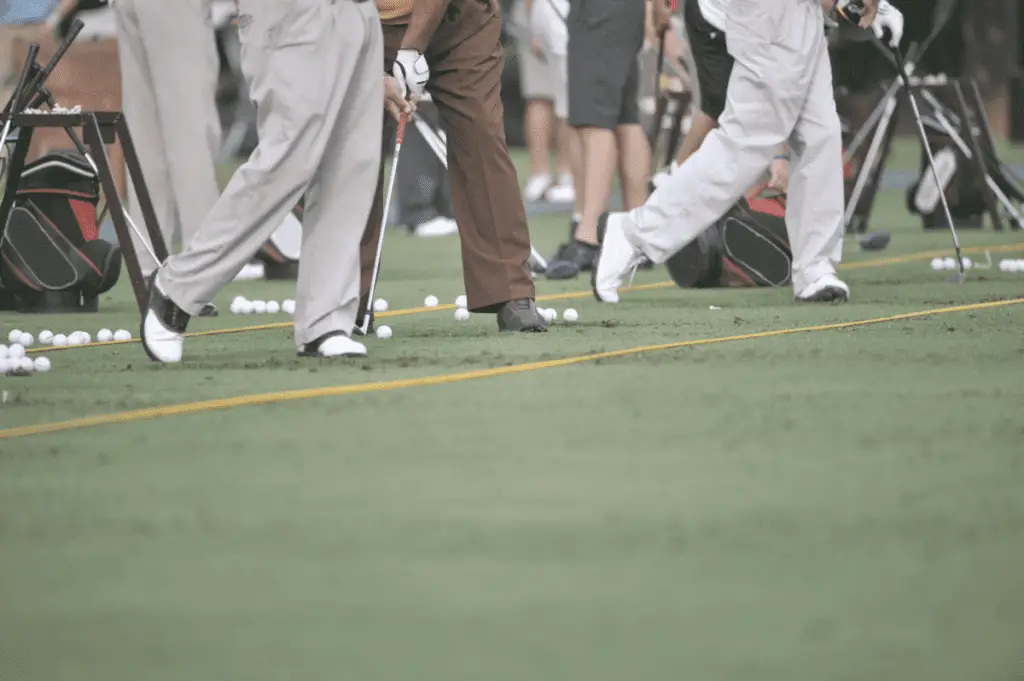
This sequence allows to warm up with short swings, while each swings gets progressively longer. Finally, we like to end with 5 wedges in order to wind down
Putting Green
Just like on the driving range, now isn’t the time to start working on something new. You’re primary goal here is to figure out how slow or fast the greens are.
To do this, we usually focus on doing some 10-15 long putts, around 25-35 feet. For this drill we like to start somewhere in the middle of the green and putt the ball as close as possible to the fringe (the edge of the green where the grass is longer).
After that, we do about 10-15 medium length putts (10-15 feet length). We want to see if we have figured out the correct speed on the green for these more makeable putts. If we sink a couple here, GREAT!
Finally, we like doing about 10-15 short putts (3-5 feet in length). The goal here is to build confidence in our stroke and know that we can sink these short ones easily!
Etiquette
Golf etiquette is like the unspoken rules of golf. You won’t get penalized for these but they’re considered common courtesy to your fellow golfers and won’t make you look like a jerk! Here are a list and quick explanation of some the most common ones a beginner golfer should know:
-
- Be quiet – when someone is swinging or about to swing, stop talking or making noise
- Don’t move – again when someone is swinging or about to, you don’t to make any distracting movements
- Fix divots – after you hit a shot on the fairway or tee box, sometimes you’ll hack out a big piece of turf. If the piece is replaceable, go ahead and put it back in place. If not, go ahead and fill it back up with the seeds you see on most golf carts or that are on the tee box
- Rake traps – if you ever hit a ball out of sand trap, you know how difficult it can be. The last thing you want to do is try to hit it out of someone’s size 12 foot print. After you’re done hitting in the sand, go ahead and use the rake to clear everything up. Make sure you place the rake back in the bunker near the edge.
- Fix ball marks – hitting the green with an approach shot is one of the most satisfying shots in golf! When this happens, your golf ball will often leave a rather big indention on the green. You want to go ahead and fix this so whoever comes after you doesn’t have putt across this indention in the green
-
- Don’t walk across a putting line – similar to fixing a ball mark on the green, you don’t want to mark up the ground for your playing partner who has to putt. With today’s soft spikes on golf shoes, this isn’t a big issue but it more just a courtesy.
- Don’t hit into another group – if there’s a group in front of you, wait for them to clear before hitting your shot. Golf balls can fly at over 100 mph and can do someone serious damage if they hit someone. Don’t be “that guy”!
- Yell “Fore” – in the event that you hit a golf shot into a group by accident, make sure to yell “fore” it’s common word for people to know to take cover!
Rules
There are so many rules in golf, it is nearly impossible to keep track of everyone and how it pertains to every situation. That’s why in any professional tournaments, there’s a rule official on hand to help interpret any situation.
As beginner golfer there’s probably only 3 that you should be aware of:
-
- You can only use a tee in the tee box
- Play the ball as it lies – unless the ball comes to rest in some sort of man made area, a cart path, a drain, a sprinkler head, etc., you normally have to play the ball as it lies)
- Lost balls – in the event that you lose a ball, the best thing to do is just drop it where you might have lost it. For water hazards, you should just drop it at the point where it entered the hazard area (I know you’re probably thinking but what about a yellow hazard! Sorry but this guide is made for beginners!). For balls hit out of bounds, you should hit from where you originally hit the ball. All of these incur a 1 shot penalty. For example, you hit your first shot into a water hazard, when you drop the ball and hit your next shot, that will be considered your 3rd shot, not your 2nd shot.
Now Go Have Fun!
There you have it, this guide serves as beginning point for those starting to play golf. I know this may be overwhelming and it may seem like a ton of information, but don’t worry about it, just go out and have fun
The game that is meant to be enjoyed and not taken too seriously, unless of course you’re playing for millions of dollars (jk)!
Golf is one of those games that for one minute you have everything figured and then 30 seconds later, you are absolutely clueless!
Now get out there, enjoy the journey, and enjoy nature.

